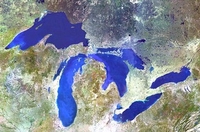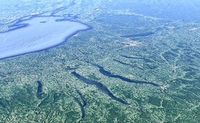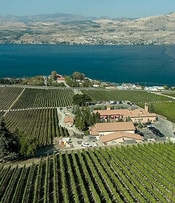Bodies of water are important factors for many vineyard sites. The moderating influence of nearby oceans, rivers and lakes can make a big difference in the quality of wines grown nearby. Here in North America, we have many of the best examples of beneficial lacustrine influence on vineyards.
Most prominent of these is the Great Lakes. Around two and a half million years ago, the first of several glacial advances occurred across the land masses of the northern hemisphere. As the ice sheets grew and moved southward, they carved deeply into the existing river valleys, broadening and deepening as they went. The ice sheets began to retreat a few thousand years ago – a blink of the eye in geologic time. As they melted, they left five freshwater seas collectively known today as the Great Lakes – Lakes Superior, Huron, Michigan, Erie and Ontario.
The U.S. Great Lakes shoreline alone totals more than 4,500 miles – longer than the U.S. East and Gulf coasts combined. The North American Great Lakes are unique among the world's large lakes in that their basins are linked together and form one continuous drainage basin that connects Minnesota to the Atlantic Ocean. Together, they constitute the greatest freshwater system on Earth. Starting in Lake Superior, the water flows into Lakes Michigan and Huron. From there, the water flows down the St. Clair and Detroit Rivers to Lake Erie. Leaving Lake Erie, it flows via the Niagara River, over Niagara Falls into Lake Ontario and thence to the St. Lawrence River and the Atlantic. Like the oceans, the lakes moderate the temperature of the air and increase the amount of rain or snow that falls on the lands surrounding them.
During the retreat of the ice sheets, the drainage patterns of the lake states changed constantly. The complex patterns and changes are still being studied. Meltwaters initially flowed south to the Gulf of Mexico, but shifted repeatedly as the ice continued to retreat and expose new drainage outlets. Many large lakes formed along retreating the ice margins, leaving remnant shoreline sand and gravel deposits perched on hillsides today. Additionally, the ice sheets dropped tons of rocks, gravel and sand that now form the land surface where the glaciers melted. The current stair-step arrangement of the lake basins has only been in place for the last 3,000 years.

Satellite View of The Great Lakes
If you travel throughout the north-central United States, you know you are in Great Lakes country. Agriculture in many forms thrives on the lakeshores. The large lakes have a profound influence on all agricultural endeavors, but particularly for grape growing. Wine grapes, more than fruits destined for the table or processing plant, are scrutinized to determine the perfect time to pick. Many microclimates around the Great Lakes owe their viticultural prowess to the presence of these massive bodies of water.
The Lake Erie AVA stretches across New York, Pennsylvania and Ohio on the southern shores of Lake Erie. Nearly 70 wineries tend to the vines here with a blend of Chardonnay, Riesling and Gewurztraminer plus varieties like La Crescent, Edelweiss and Chambourcin and Noiret.
Winegrowing on the Niagara Escarpment of Ontario is made possible by the lake’s influence. The same limestone cliffs that form Niagara Falls extend westward into Ontario and ultimately in an arc across northern Michigan and into Wisconsin. During the cold winters, the escarpment holds the warmer lake air in place. The narrow band between the lakeshore and cliffs is wine country. The Beamsville Bench, Twenty Mile Bench, Niagara-on-the-Lake and other growing areas are thus protected from killing temperatures. Riesling, Chardonnay, Gamay, Pinot Noir and more are all successful here thanks to Lake Ontario’s influence.
Michigan is among the most glaciated of states. Most of the land surface is covered glacial “drift” – the mélange of gravel, sand, clay and detritus that settled on the surface when the massive glaciers melted. The most noted Michigan wines come from the Leelanau Peninsula AVA and the Old Mission Peninsula AVA. These two parallel AVAs extend into Lake Michigan from Traverse City and benefit from the moderation of the lake. Vineyards are supplanting former cherry and apple orchards as the reputation of the wines grows. Fine sparkling wines are justifiably accorded high praise. There are many excellent bottlings of Riesling, Pinot Blanc, Gewurztraminer, Pinot Noir and more that come from these AVAs. There is justified excitement about the quality potential of northern Michigan wines.
The Lake Michigan Shore and Fennville AVAs in the southwest part of the state are best known for red wines. Located 200+ miles south of Traverse City, the area is slightly warmer. Many excellent examples of Cabernet Franc, Syrah and Blaufränkisch are produced here. The quality of the best wines can compete with similar-priced wines from anywhere.
There is a burgeoning winescape on the western shore of Lake Michigan as well. The Door Peninsula of Wisconsin is a continuation of the arc of hard carbonate rocks that form the Niagara Escarpment. The peninsula juts out into the lake from Green Bay and is recognized as the Wisconsin Ledge AVA. There are 24 bonded wineries here and most plant cold hardy varieties like La Crescent, Frontenac and Brianna. The lake influence moderates the climate and a few sites planted to Riesling and Chardonnay. There are even a few wineries on Michigan’s Upper Peninsula, truly the edge of viable viticulture in this part of the world.
There are more great lakes for viticulture than just The Great Lakes. The Finger Lakes of New York have resulted from the same glacial sculpting. Although the area has a century plus of winegrowing history, it was not until the New York Farm Winery Law was enacted in 1976, allowing wineries to sell their wines directly to consumers, that the industry began to blossom. Now, forty-five plus years later, the number of wineries in New York has grown from a mere 19 in 1976 to over 400 today in the state and 100+ in the Finger Lakes. Wine tourism is now a big business in the Finger Lakes and many wineries have facilities to support concerts and weddings in addition to tasting rooms.

Lake Ontario and the Finger Lakes of New York
Today, there are three AVAs in the area – Finger Lakes, Seneca Lake and Cayuga Lake. Vinifera grapes are widely planted in the warmest sites along the lakeshores, but there are still many plantings of hybrid and native vines. Of the 9000+ acres of vineyard in the Finger Lakes, about 23% are vitis vinifera. Riesling accounts for about a third of the vinifera plantings, but there is increasing interest in red varieties. Cabernet Franc, Pinot Noir and Merlot comprise about twenty percent of vinifera vineyards.
Lake Champlain forms 100 miles of the border between New York State and Vermont. The lake is quite far north and extends into Canada at its northern terminus, but it does provide grape and fruit growers with enough climatic moderation to allow ripening. There is a small but growing group of wineries on the Vermont side producing tiny amounts of sometimes quite attractive wines.

Lake Chelan AVA Vineyards
In the western US, there are fewer lakes and less profound influence but there are some notable sites. The Lake Chelan AVA is set on the shores of the eponymous, deep, glacially-carved lake in Washington. There are thirty or so wineries in the AVA making Chardonnay, Riesling, Syrah and a wide range of other varieties. In northern Montana, there is a very small wine industry springing up in the Flathead Valley. Flathead Lake is a tiny remnant of what was glacial Lake Missoula. As the great continental glaciers receded, ice dams some 2,000 feet high formed and repeatedly ruptured, sending vast volumes of floodwaters across eastern Washington to the Pacific and carving the Columbia Valley landscape in the process. While there are plenty of wineries in California, few have a strong lacustrine influence. The growing areas around Clear Lake, north of Napa and Sonoma in Lake County, benefit from the moderating influence of the lake waters there.
If you are seeking a travel destination this summer, give a thought to exploring some of the vineyards surrounding our great lakes and our Great Lakes. There is a great deal to discover among the local vineyards and beyond.
More by Wayne: Wayne Belding